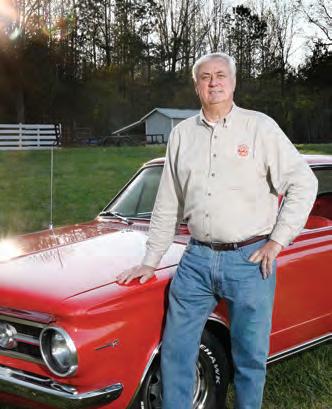
27 minute read
More Power
from 2023-02-CCEC
Wake Electric’s Privette Posthumously Awarded Order of the Longleaf Pine
Late director’s family received the award on his behalf
On Dec. 8, former Wake Electric Director Rodney Privette was posthumously awarded the Order of the Long Leaf Pine. Since 1963, North Carolina’s governors have reserved the award as the highest honor for persons who have made significant contributions to the state and their communities through exemplary service and exceptional accomplishments.
Privette passed away unexpectedly in August. He had served on the Wake Electric Board of Directors since March 2016. The award was presented to Privette’s family by NC Senator Sarah Crawford and NC Representative Terence Everitt. Donnie Lawrence, current chief of the Rolesville Rural Fire Department, coordinated the presentation, which coincided with the annual meeting for the fire department.
“Rodney’s impact on our community is an inspiring example of leadership to everyone who knows him,” said Wake Electric Board President Suzy Morgan. “As a Rolesville native, Rodney’s community ties ran deep, and Wake Electric celebrates the mark he left on the cooperative as well as public safety and economic development in our area.”
In addition to serving on the Wake Electric Board of Directors, Privette had served as chief of the Rolesville Rural Fire Department since 1992 where he had begun as a volunteer firefighter in 1975. He also served on the Wake County Fire Commission, helped form the Rolesville Chamber of Commerce, served on the board of the Wake Forest Federal Savings & Loan and co-owned Privette Insurance Agency with his sister. He was also a devoted, lifelong member of the Rolesville Baptist Church.
(L to R) Privette’s family receiving the award were fiancée Susan Cashion; daughter Brandi Privette and her fiancé Kevin; Niki Privette and grandsons Carson, Hunter and Andrew, and son Coy Privette. NC Sen. Crawford and NC Rep. Everitt presented the award.
In his spare time, Privette would restore old cars, including a 1965 Plymouth Barracuda that was once owned by a U.S. Army soldier who died in Vietnam (“The Compassionate Collector,” May 2020, page 14).
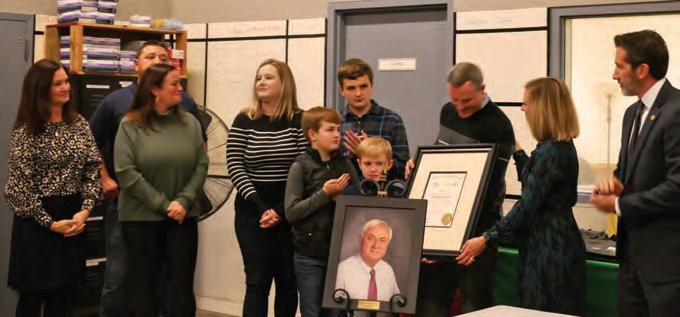

Students: Apply Now for Basketball Camp!
Rising sixth and seventh graders can now apply for a Touchstone Energy Sports Camp Scholarship to attend basketball camp in June. Wolfpack Women’s Basketball Camp NC State University Raleigh Carolina Basketball School The University of North Carolina Chapel Hill
Powering A Brighter Future
North Carolina’s Electric Cooperatives are enhancing reliability and advancing our service to consumer-members with cutting-edge technology as part of our Brighter Future vision.



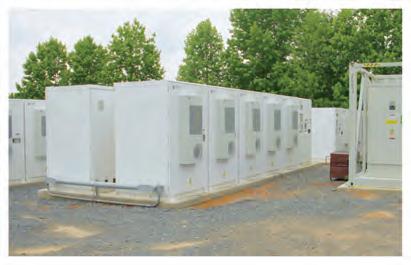
Learn about our 5 microgrids, 10 battery energy storage systems, 13 solar + storage sites and more.
rural A fresh start for healthcare
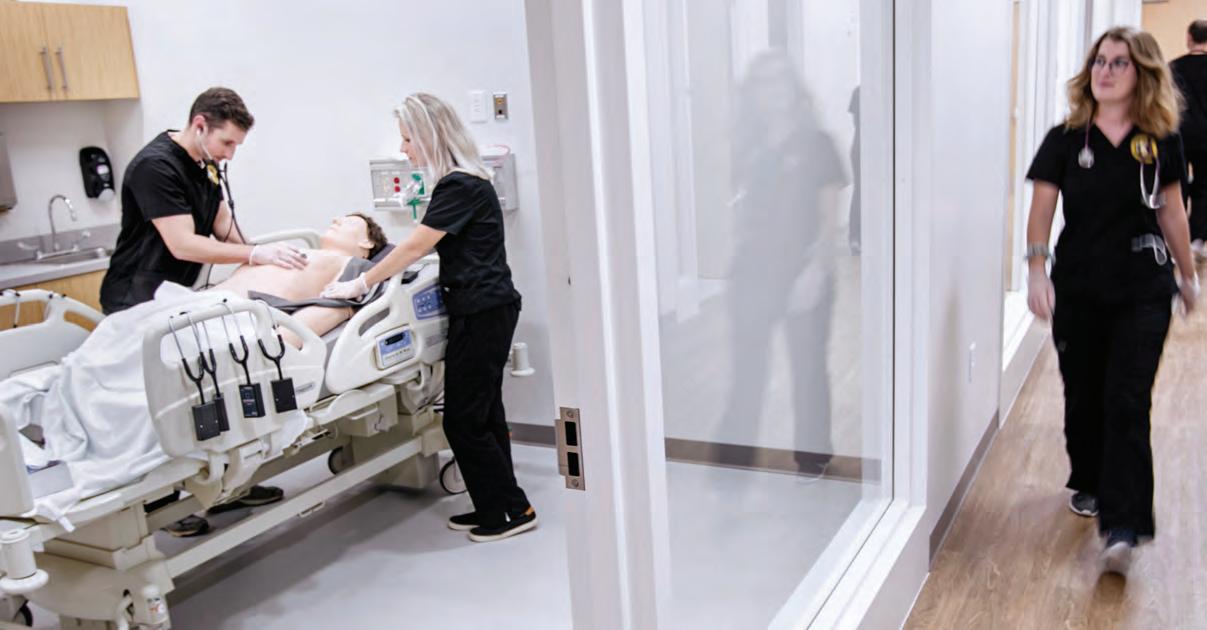
Training the next generation of rural doctors
By Sarah Thompson
Before Cannon Memorial Hospital’s labor and delivery unit closed in 2015, Dr. Benjamin Gilmer delivered one of the last babies to be born in an Avery County hospital. The unit where his cousins were born is gone because it was no longer seen as cost-effective to provide obstetrical care in the county, Dr. Gilmer explains.
Dr. Gilmer is the medical director of the Rural Health Initiative and Rural Fellowship at the Mountain Area Health Education Center (MAHEC), the largest of nine area health education centers in the state, which address the supply, retention and quality of health professionals, particularly in rural communities. Before joining MAHEC, he lived and worked as a doctor in rural North Carolina. He believes that inspiring the next generation of doctors is the best way to help rural places not only survive, but attain health literacy and gain access to specialized doctors educated on social justice in health advocacy.
Counties in need The North Carolina Institute of Medicine describes primary care providers as “the entry point into the health care system.” Access to their care is associated with fewer health disparities and better health among various socioeconomic statuses. The target primary care provider to population ratio should be equal to roughly 6.6 providers per 10,000 patients, according to the Institute. This ratio symbolizes how access to providers improves overall health of communities and can prevent a diagnosis or injury from becoming a NC Primary Care Physicians 2021, by county Greater than recommended minimum of 6.67 per 10,000 patients Below the recommended minimum critical health issue. Yet many rural counties in North Carolina fall far short of this ratio (see map). The gap between access to health providers in rural versus urban counties is not just an inconvenience, it’s causing serious health disparities that doctors like Benjamin Gilmer want students to understand — and want to change.

Rural training Dr. Crystal Gaddy worked in rural healthcare systems for more than 18 years. She has witnessed its shortfalls firsthand. Today, she is an associate professor at Pfeiffer

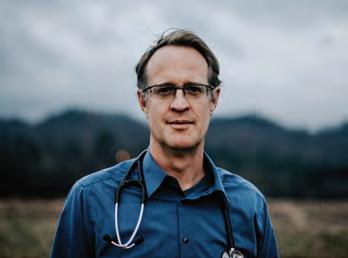
University’s Master of Science in Occupational Therapy program in Stanly County, where she and other faculty echo the significant need for students to practice medicine in rural areas.
“We’re able to, along with other faculty, really teach and educate our students with the hopes that they will, at least initially or at sometime within their careers, serve those who are really underserved,” Dr. Gaddy says. “From the moment the students enter Pfeiffer’s Occupational Therapy Program, that is the main focus.”
Pfeiffer University’s graduate program in Occupational Therapy (OT) began about two years ago alongside their Physician Assistant (PA) Studies program. As their brandnew building started construction and faculty got together to discuss curriculums, rural health was always a part of the conversation. The most pressing issue discussed was the shortage of health providers in rural regions.
Assistant Professor of Physician Assistant Studies and Randolph EMC member Dale Patterson says that it is extremely difficult to keep providers in rural places. When he’s not at the university, Dale continues to provide clinical care once a week in his local county, Montgomery. At Pfeiffer, students learn about the need for their skills in rural areas, but also the unique opportunities that practicing and living in a rural community can bring.
Students discover this for themselves during their required fieldwork. Both the OT and PA programs place students across the country, and the world, to work with health providers and experience what it means to serve and be a part of a community. Dr. Gaddy believes that rural fieldwork is where students get the chance to show off their creativity and critical thinking.
“The best place to be creative is within rural healthcare,” Dr. Gaddy says. “When you have access to everything in the world, you don’t have to critically think as hard. With our students — with us trying to push them within those fieldwork areas and those opportunities in places we call ‘emerging areas’ — it shows them that anything is possible.”
Universities and rural health organizations try to motivate students to practice in rural areas through scholarships, loan forgiveness and other incentives. When Dale was in school, he received a National Health Service Corps scholarship and advises his students to take advantage of those opportunities, which give them more financial freedom to serve communities in need.
Desiring the work Back in Western North Carolina, Dr. Gilmer works 60 to 80 hours a week trying to recruit the newest generation of doctors to practice in rural places. Over the past five years, they’ve placed approximately 30 doctors in western regions of the state. The Rural Health Initiative (RHI) has become the largest recruiter of the health professionals in the mountains and are busy looking to place more psychiatrists, general surgeons and obstetricians.
Like Pfeiffer, Dr. Gilmer advises students to look for avenues of support that can ease their transition into rural health systems. He explains the three pillars of support that RHI utilizes to attract and retain health professionals in western North Carolina. First, they talk with high school students to inspire them to give back to their community by becoming a rural care provider. Second, they recruit, train and support students through their schooling by providing scholarships, special training for rural care and connecting them with communities early on. Third, they support practices so that they feel well-capacitated and that they’re a part of a much larger mission.
Hope for the future The work is exhausting yet rewarding. Doctors and local citizens are dedicating their lives to advocate and save lives in rural communities because they know everyone deserves the best care, no matter where they live. These advocates of rural healthcare find solace in those they work with and in the changes they’re seeing in the eyes of their students, patients and communities.
Dr. Benjamin Gilmer
Corey Nolen
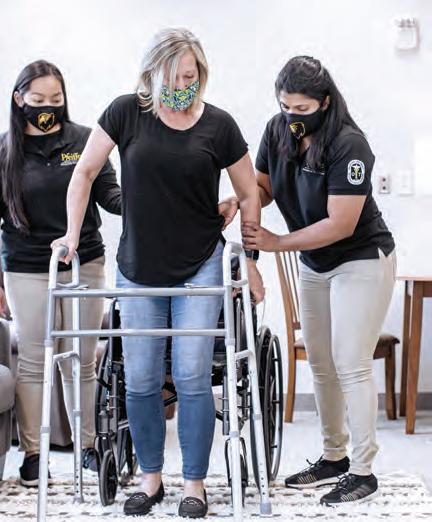
Sarah Thompson was a Carolina Country editorial intern in 2022. She is currently pursuing a journalism degree from UNC Chapel Hill.

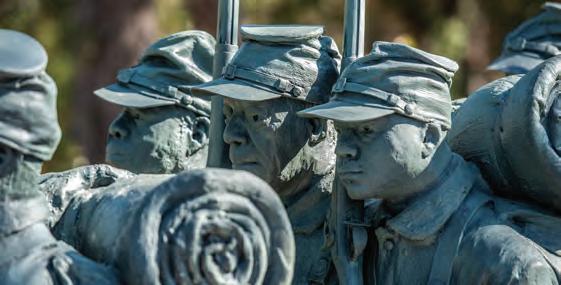
Alan Cradick Stephen Hayes
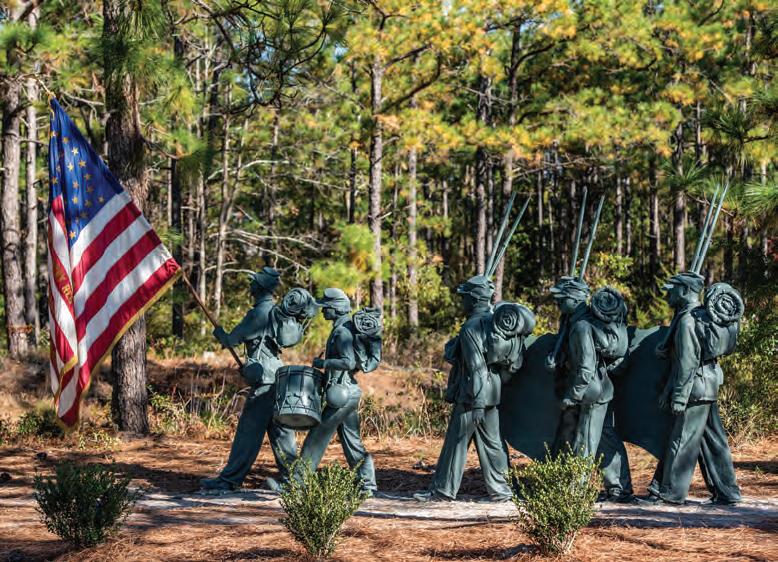

Cameron Art Museum
Marching Toward Freedom
Stephen Hayes honors Black history through sculpture
By Vanessa Infanzon
In 2019, the Cameron Art Museum approached Durham-resident and sculptor Stephen Hayes about memorializing the United States Colored Troops (USCT) who marched through Wilmington during the Civil War Battle of Forks Road in 1865. Stephen accepted the challenge to create the memorial.
Stephen’s creation — “Boundless,” a life-size bronze statue of 11 African American men — was unveiled in November 2021 on the grounds where the Battle of Forks Road was fought. The permanent exhibit is also the focal point at the only park in the nation built to honor the United States Colored Troops and their fight for freedom.
In the early stages of developing sketches for the sculpture, Stephen immersed himself in the history of the battle by walking the site and meeting the United States Colored Troops reenactors from Battery B 2nd United States Colored Light Artillery, USCT 35th Regiment Tryon Palace New Bern, and the 5th USCT Company C. While in character, these men gave Stephen a history lesson explaining what it was like to march and what kinds of clothing and shoes were worn. These soldiers didn’t have the benefit of making the trek on horses.
Each soldier’s face is based on a real person. At Stephen’s request, the museum put out a call for descendants of the soldiers and reenactors to pose for the sculpture. Stephen casted their faces, using plaster gauze to capture the details in a mold which would later be filled with plaster. The hands were cast from another group of people, veterans and additional descendants of the soldiers.
Unlike most monuments, Stephen intentionally placed “Boundless” on the ground, not on a pedestal. He wants viewers to question how this monument speaks to ones they’ve seen mounted on a tall platform.
Once the plaster mold was ready, Stephen reached out to Carolina Bronze Sculpture, Inc., in Seagrove about casting the piece in bronze. The large multifigure casting was complex, says Ed Walker, president of Carolina Bronze. He and Stephen worked closely together.
“(Stephen) is a visionary,” Ed says. “He can create pieces that have strong statements about societal changes, especially about the plight of African American people. He’s highly respected in my book in his ability to convey those types of images so that people can view and experience his sculpture, and lead with a new sensibility about important social issues.”
Vanessa Infanzon moved to Charlotte for college and never left. When she’s not writing about business or travel, she’s paddle boarding on the Catawba River.
MEMBERNews

CARTERET-CRAVEN ELECTRIC COOPERATIVE
Powered by our members!
Hayden Crump Apprentice Line Technician
2022 ends with series of outages
Our commitment to you

A lot of retail business chains have begun asking patrons if they want to “round up” their bills for a specific charity.
Co-op members have been
“rounding up” since 1999, and the more than $3.81 million raised has been spread across multiple charities for the benefit of local individuals.
Through contributions of less than $1 each month, children with food insecurity receive meals for
Nearly every Carteret-Craven Electric Cooperative member experienced a loss of power at their home or business through a series of outages as 2022 came to a close.
Each of the outages had its own unique source, two of which had never been felt before by North Carolinians — substation vandalism and rotating power interruptions necessary to stabilize the grid during extreme temperatures (Read more on page 4).
Regardless of how extraordinary the circumstances, we know these events impacted your home, life and work routines, and holiday celebrations. Yet through it all, you were there with kind words and expressions of concern and appreciation for the dedicated teams working to restore your power.
We take our responsibility of providing you with reliable electricity very seriously; it’s a core part of our Brighter Future vision through which we are integrating new grid technologies and in-the-home solutions Small change helps to change lives the weekend, members receive assistance with electric bills, college scholarships are awarded, teachers receive grants and so much more. Visit ccemc.com/RoundUp to learn more about Operation RoundUP® and the programs it supports. If you already participate RoundUP® , THANK YOU! If you are not "rounding up," email customerservice@ccemc.com or call 252.247-3107 to enroll.
that will allow members to precisely manage their electric use, while also making the grid more efficient and resilient. There will always be factors that we have minimal control over, but my commitment to you is that the cooperative will do everything we can to limit outages and restore power as quickly as possible when outages inevitably occur. During outage events, you can count on us to provide updates regarding the restoration process and the information you need to help make plans for your family or business. Each day I recognize that it is a privilege to provide electricity to 42,000 homes and businesses across Carteret, Craven, Jones and Onslow counties. Because to me, electricity is far more than electrons — it’s the power behind hot meals, warm homes, and so many aspects of our lives, from watching the nightly news to high-schoolers playing under the lights. That's why we are casting an eye to the future, carefully evaluating additional measures we can employ to further enhance grid resilience, substation security, and power reliability. Every decision we make is made with you in mind. Providing you, our members, with safe, reliable, and affordable electricity will always anchor our actions. on the web Thank you, members. Apply Now! Community college scholarships are available. Learn more at ccemc.com/Scholarships
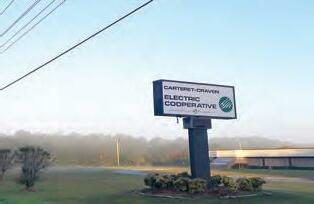
Carteret-Craven Electric Cooperative See you at the annual meeting
Mark your calendar for May 4, when CarteretCraven Electric Cooperative (CCEC) will host our annual meeting for you, the members we proudly serve. Co-op employees and board members always look forward to this event because it’s a great opportunity to talk with our members and hear what’s on their minds.
We hope you’ll join us for the 2023 Member Celebration and Annual Meeting, which will take place at Glad Tidings Church in Morehead City. Members will enjoy a delicious meal, hear performances by the Broad Creek Middle School Band and Croatan High School Chorus, learn more about the cooperative, and have the chance to win cash, free electricity and a retired co-op truck!
Spending time with you and hearing your take on our community’s energy future is so important to us. In fact, it’s essential because everything we do is shaped by the members of our community. The energy industry is in the midst of massive change. Consumer needs and changing technology impact nearly every aspect of how we manage and deliver energy to local homes, schools and businesses.
As we navigate major changes in the coming years, we need to hear from you and your neighbors to inform our planning as we strive to meet the longterm needs of all CCEC members. You have a say in your cooperative
You may be wondering if your opinion really makes a difference, and yes, it does! Gaining guidance and perspective from our members and board helps set priorities for the co-op and guide future decisions.
At our annual meeting, we discuss issues that impact the general membership (that’s everyone who pays for electric service from CCEC). The annual meeting is also a time for members to vote on the co-op’s board of directors (see page 13 for more information).
Our board of directors is comprised of nine members who live and work right here in our local service area, so they are in the best position to know where community investments are most needed. And by the way, we hope you’ll consider running for the board in the future — we’re always looking for folks who care about our community who would be willing to serve. Investing in our community
This local input means those closest to the community know its needs and priorities and help direct where co-op dollars are spent. Every year, we invest funds to make updates to our local system, which helps maintain reliability and grid resilience. Think of it this way: every time you pay your electric bill, you’re actually investing in your community because all the money we take in stays here in the local community. By making these investments in our local system, we can ensure you have reliable power for everyday life.
Most consumers likely don’t equate active involvement with their electric company with helping their community. But Carteret-Craven Electric Cooperative is not an ordinary utility company. We’re a co-op, and our business model is meant to serve the members and the community in which it operates.
Our core purpose and mission are to provide safe, reliable and affordable power. But as a cooperative, we’re also motivated by service to our community, rather than profits.
We hope you’ll exercise the benefits of your co-op membership and join us for the annual meeting on May 4 at 5 p.m. We look forward to seeing you!
High school scholarship deadline is March 1
CCEC and the Carteret-Craven Electric Foundation will award five scholarships to high school seniors entering college this fall.
The scholarships pay each student $1,000 a year for up to four years of college. The program is open to students who live in a home that gets electricity from the cooperative.
One student each from East Carteret, West Carteret, Croatan and Havelock high schools will be selected to receive the scholarship. The fifth recipient will be the next highest scoring applicant and may include students from other schools, such as Jones Senior High School, early colleges, Gramercy Christian School and home schools.
CCEC and the Carteret-Craven Electric Foundation have awarded more than $480,000 in scholarships to high school seniors since 2000. The judges will weigh the following in determining the scholarship winners: need, 50 percent; academic achievement, 25 percent; and extracurricular activities, 25 percent. Additional requirements and the application are available online at ccemc.com/scholarships. Applications are also available from the school counselors' offices and our offices in Newport and Havelock.

MEMBER
CELEBRATION

AND ANNUAL MEETING
Planning for the 83rd Annual Meeting of CarteretCraven Electric Cooperative (CCEC) is underway and after holding the annual meeting virtually the past three years, we are excited to be able to meet with you again, in person, at Glad Tidings Church in Morehead City. Director elections
As a member of the cooperative, you have the opportunity to vote for your Board of Directors each year. CCEC’s service area is divided into nine districts. The terms for the directors from districts 6, 7 and 9 expire this year. Directors are elected for three-year terms. Incumbent directors seeking nomination are:
For District 6: Doug Fulcher
For District 7: Anthony Nelson
For District 9: Alvin West
The Board of Directors has appointed a Nominating Committee, consisting of two members each from districts 6, 7 and 9. The committee will nominate one or more members to run for election from each of these districts.
Candidates may also be nominated by petition of 50 or more individual co-op members from their district. Only one signature is allowed for joint accounts. The petition must be submitted and certified before 5 p.m. on March 3.
For more information about the nominating committee or petitions, contact CEO Jake Joplin at 252.247.3107.
Voting for director positions, in addition to any other business conducted as part of the annual meeting, shall be done by those who have been members at least 30 days before the meeting. Each member shall have one vote regardless of number of accounts.
To serve on the Board of Directors, members must:
District Descriptions
District 6 (Doug Fulcher, incumbent): Cooperative-served properties in Carteret County east and north of Highway 70 and west of the Intracoastal Waterway.
District 7 (Anthony Nelson, incumbent): All cooperative service areas east of the Intracoastal Waterway.
District 9 (Alvin West, incumbent): An at-large board seat held by a minority cooperative member from any part of the cooperative’s service area.
Bylaws Summary
Ò Have been a member for no less than two years. Ò Receive electric service from CCEC at his or her primary residence, which must be in the director district that he or she represents. Ò Be a United States citizen. Ò Be at least 18 years old. Ò Not have been declared mentally incompetent unless competency has been legally restored. Ò Not have been convicted of a felony or any misdemeanor involving moral turpitude. Ò Not be a close relative of a CCEC employee or incumbent member of the Board of Directors, and, at the time of taking office, not be a close relative of a former member of the Board of Directors who resigned from the board or died within two years before taking office. Ò Not be employed by or financially interested in a competing enterprise or a business selling electric energy, service, or supplies to CCEC, and not have been employed by CCEC or have previously been an officer or director of, or employed in any policy-making position by any electric membership cooperative or investor-owned electric utility company.
Full details of director qualifications are included in the cooperative's bylaws (ccemc.com/Bylaws).
Additional information about the annual meeting, including ballots for election of directors, if needed, will appear in the April issue of “Member News.”
Carteret-Craven Electric Cooperative Keeping warm and safe with space heaters
Space heaters, including electric models and those powered by kerosene, are a convenient source of warmth during winter, especially if there’s a power outage, but they can be dangerous if not used properly.
Heating equipment is the second leading cause of home fires in the United States. More than 65,000 home fires are attributed to heating equipment each year, resulting in hundreds of deaths, thousands of injuries and millions of dollars in property damage.
Stay warm and safe this winter by following these tips from the Electrical Safety Foundation International for using space heaters: è Make sure your space heater has the label showing that it is approved by a recognized testing laboratory. è Before using any space heater, read the manufacturer’s instructions and warning labels carefully. è Install smoke alarms on every floor of your home and outside all sleeping areas. Test them each month. è Inspect heaters for cracked or broken plugs or loose connections before each use. If frayed, worn or damaged, do not use the heater. è Never leave a space heater unattended. Turn it off when you're leaving a room or going to sleep, and don't let pets or children play too close to a space heater. è Space heaters are only meant to provide supplemental heat and should never be used to warm bedding, cook food, dry clothing or thaw pipes. è Heaters must be kept at least three feet away from anything that can burn, including papers, clothing and rugs. è Locate space heaters out of high traffic areas and doorways where they may pose a tripping hazard. è Plug space heaters directly into a wall outlet. Do not use an extension cord or power strip, which could overheat and result in a fire. Do not plug any other electrical devices into the same outlet as the heater. è Place space heaters on level, flat surfaces. Never place heaters on cabinets, tables, furniture or carpet, which can overheat and start a fire. è Always unplug and safely store the heater when it is not in use.

Swoosh! Don't miss this summer opportunity
Do you know a middle schooler who loves basketball and wants to gain experience training alongside real college basketball players and coaches? We have great news for you!
We are accepting applications for full scholarships to basketball camps at two North Carolina universities this summer. Young men can apply for a scholarship to attend the Carolina Basketball School at UNC - Chapel Hill June 17-21, and young women can apply for a spot at the Wolfpack Women’s Basketball Camp held in June at N.C. State University in Raleigh.
Students who will be in sixth or seventh grade during the 2023-2024 school year are eligible to apply. All applicants must have a parent or guardian’s signature, and scholarship winners are responsible for their own transportation to and from camp.
The online application can be found at ccemc.com/SportsCamps, and the deadline to apply is March 31.

Offices
1300 Highway 24 Newport, NC 450 McCotter Blvd. Havelock, NC
Contact
I ‘Bearly’ Made It Out Alive
A 12-inch stainless steel knife for only $79
Stauer® Impossible Price ONLY 79

What Stauer Clients Are Saying About Our Knives
“The feel of this knife is unbelievable... this is an incredibly fine instrument.” — H., Arvada, CO
“This knife is beautiful!” — J., La Crescent, MN
EXCLUSIVE FREE

It was a perfect late autumn day in the northern Rockies. Not a cloud in the sky, and just enough cool in the air to stir up nostalgic memories of my trip into the backwoods. is year, though, was di erent. I was going it solo. My two buddies, pleading work responsibilities, backed out at the last minute. So, armed with my trusty knife, I set out for adventure. Well, what I found was a whole lot of trouble. As in 8 feet and 800-pounds of trouble in the form of a grizzly bear. Seems this grumpy fella was out looking for some adventure too. Mr. Grizzly saw me, stood up to his entire 8 feet of ferocity and let out a roar that made my blood turn to ice and my hair stand up. Unsnapping my leather sheath, I felt for my hefty, trusty knife and felt emboldened. I then showed the massive grizzly over 6 inches of 420 surgical grade stainless steel, raised my hands and yelled, “Whoa bear! Whoa bear!” I must have made my point, as he gave me an almost admiring grunt before turning tail and heading back into the woods.
I was pretty shaken, but otherwise ne. Once the adrenaline high subsided, I decided I had some work to do back home too. at was more than enough adventure for one day. Our Grizzly Hunting Knife pays tribute to the call of the wild. Featuring stick-tang construction, you can feel con dent in the strength and durability of this knife. And the hand carved, natural bone handle ensures you won’t lose your grip even in the most dire of circumstances. I also made certain to give it a great price. After all, you should be able to get your point across without getting stuck with a high price. But we don’t stop there. While supplies last, we’ll include a pair of $99 8x21 power compact binoculars FREE when you purchase the Grizzly Hunting Knife. Make sure to act quickly. The Grizzly Hunting Knife has been such a hit that we’re having trouble keeping it in stock. Our first release of more than 1,200 SOLD OUT in TWO DAYS! After months of waiting on our artisans, we've finally gotten some knives back in stock. Only 1,337 are available at this price, and half of them have already sold!
Knife Speci cations:
Join more than 322,000 sharp people who collect stauer knives

Stauer 8x21 Compact Binoculars -a $99 value-
with your purchase of the Grizzly Hunting Knife TWO DAYS! After months of waiting on our artisans,
• Stick tang 420 surgical stainless steel blade; 7 ¼" blade; 12" overall • Hand carved natural brown and yellow bone handle • Brass hand guard, spacers and end cap • FREE genuine tooled leather sheath included (a $49 value!)
The Grizzly Hunting Knife $249 $79* + S&P Save $170 California residents please call 1-800-333-2045 regarding Proposition 65 regulations before purchasing this product.
* Special price only for customers using the offer code. 1-800-333-2045
Your Insider Offer Code: GHK227-02
Stauer, 14101 Southcross Drive W., Ste 155, Dept. GHK227-02, Burnsville, MN 55337 www.stauer.com Stauer® | AFFORD THE EXTRAORDINARY ®


